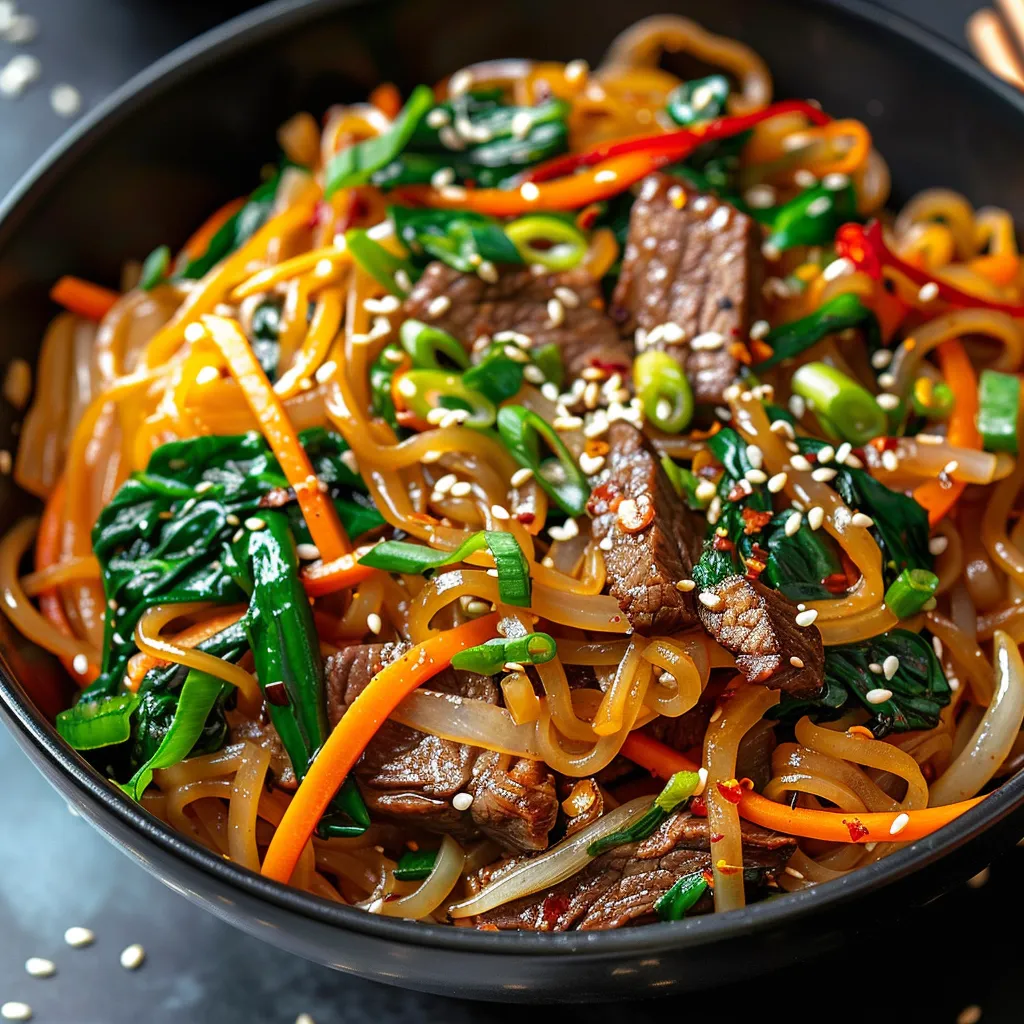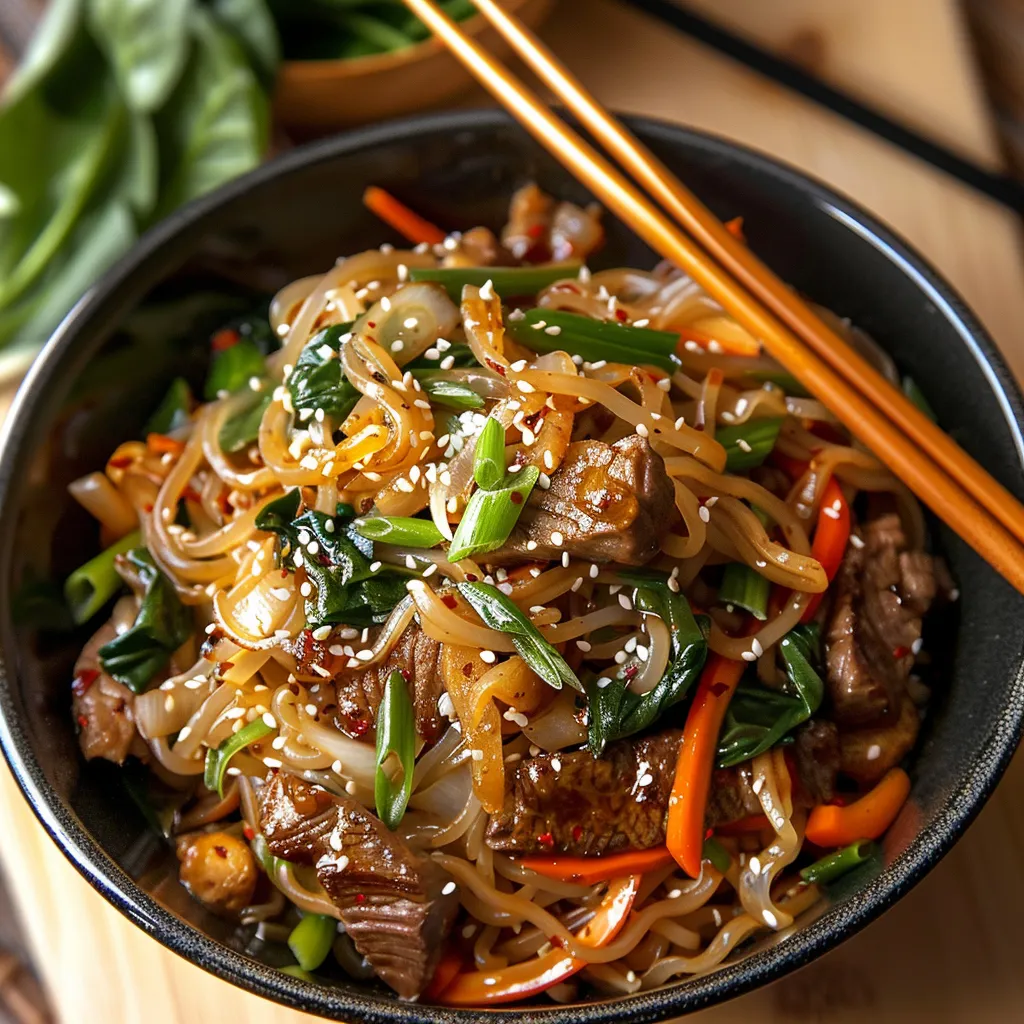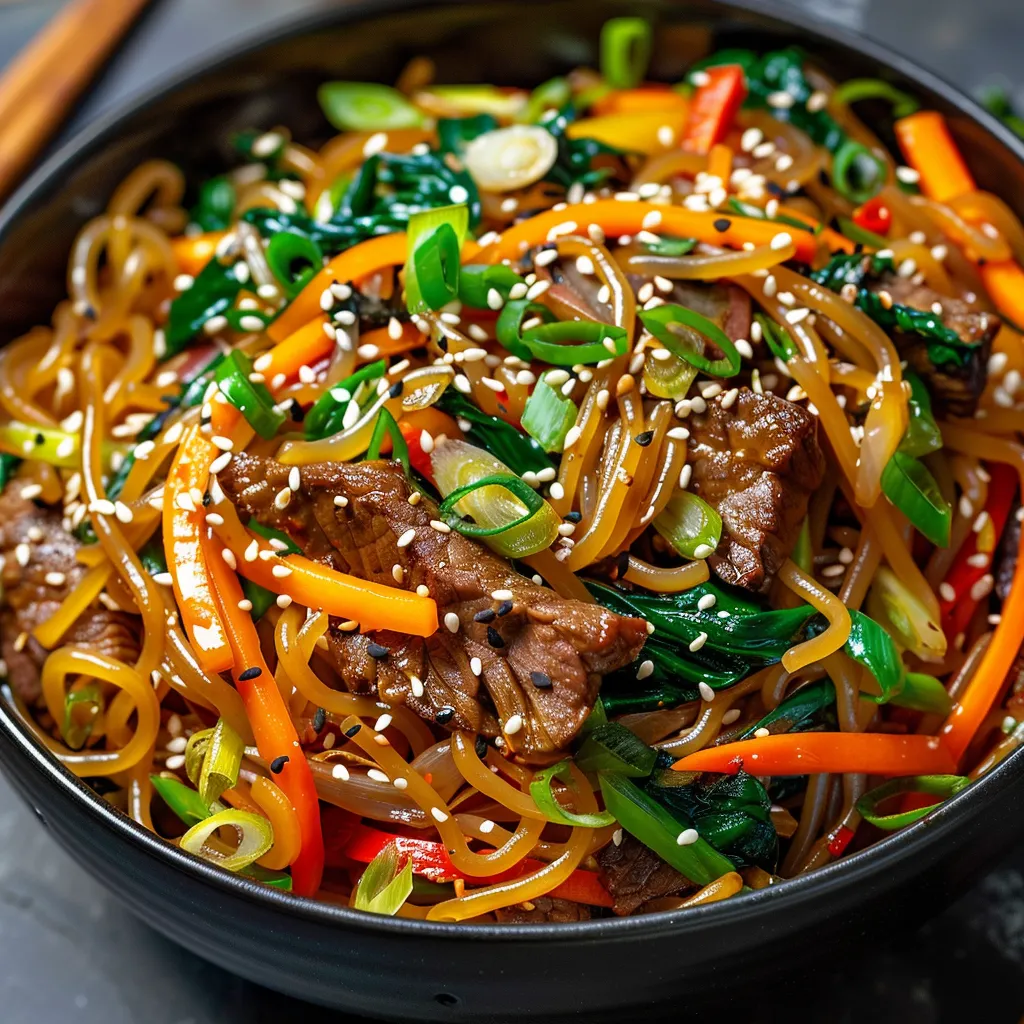 Pin it
Pin it
Japchae showcases the brilliance of Korean cooking, turning basic sweet potato noodles into a colorful mix of textures and tastes. Everything gets its own special treatment before coming together beautifully - from the stretchy dangmyeon noodles glistening with nutty oil to the colorful veggie mix that keeps its unique bite. The soft, flavor-packed beef adds richness, while the careful mix of seasonings creates something that's savory, slightly sweet, and totally satisfying. This Korean favorite shows off the perfect mix of colors, textures, and flavors that makes Korean food so special in its balanced approach.
I first learned about Japchae in a family-run Korean kitchen, where I found out that getting the timing and heat just right matters as much as picking good ingredients. After making it countless times, I realized the real secret is knowing how each part reacts to heat and mixes with the sauce. This know-how, handed down through many generations of Korean home cooks, helps make sure every serving of Japchae turns out amazing.
Picking Perfect Ingredients
- Sweet potato noodles: Need a good once-over before buying. Go for grayish white, even strands without any weird colors or breaks. They should feel solid and bounce back a bit when you press them
- Beef short ribs: Have to be super fresh with good fat running through. Pick pieces that look bright red with visible fatty streaks for the tastiest, most tender results
- Shiitake mushrooms: Look for solid, smooth caps with a rich brown color. Good ones will smell earthy and won't be wet or soft
- Fresh vegetables: Don't grab just any. Carrots need to be hard and bright orange, spinach should have crisp dark green leaves, and bell peppers ought to feel heavy with shiny skin
- Toasted sesame oil: Worth being picky about. Pick bottles kept away from sunlight with a rich, nutty smell. Check when they were made to make sure they're fresh
Making Wonderful Japchae
- Noodle Preparation:
- Start with well-cooked dangmyeon, checking often for that special chewy feel. Watch these noodles carefully while cooking - too quick and they stay hard, too long and they turn mushy. Get a big pot of water really boiling, then add noodles slowly so they don't stick together. Stir now and then and try a piece after five minutes by taking one out and biting it. The perfect noodle looks clear but still fights back when you bite. Throw them in cold water right away to stop cooking and keep that perfect texture.
- Vegetable Orchestration:
- Cook each veggie on its own to bring out what makes it special. Start with onions, letting them get golden edges for extra flavor. Then do mushrooms until they lose their water and start to brown. Cut carrots into same-size matchsticks so they cook evenly and look nice. Spinach needs just a quick toss in the pan, just enough to soften while staying bright green. This step-by-step approach makes sure each veggie adds its best flavor and texture to your dish.
- Protein Perfection:
- Soak beef slices in a mix of soy sauce, garlic, and sesame oil. Make sure the sauce covers each piece, with sugar helping to make them brown nicely when cooked. Let them sit at least twenty minutes for flavor to sink in, but not more than two hours or they'll get too salty. Cook small batches on very high heat, spreading them out so they're not crowded. Each piece should get golden brown outside while staying soft inside.
- Final Assembly:
- Put everything together carefully in your biggest mixing bowl, starting with sauce at the bottom. Add noodles next so they can soak up the flavors. Put veggies in by color to make it look pretty before mixing. Use two spoons or clean hands to gently toss everything together, making sure sauce gets everywhere without breaking the noodles.
 Pin it
Pin it
Delightful Serving Ideas
Serve your Japchae with care, paying attention to temperature and side dishes. It tastes best when just a little warm or room temperature, letting all the flavors really come out. Put it on a big, pretty plate or in separate bowls, and sprinkle extra sesame seeds and slanted-cut green onions on top. Try serving it with traditional Korean sides like kimchi, which adds a tangy spiciness that works great with Japchae's mild sweetness. Small dishes of extra sesame oil and soy sauce let everyone adjust the taste to what they like.
Tasty Twists
While respecting the traditional way of making it, you can try different takes that stay true to what makes this dish special. Maybe swap the beef for juicy pork belly strips with the same seasonings plus some gochugaru for a bit of heat. If you want a veggie version, use pan-cooked king oyster mushrooms, cut lengthwise to feel like meat when you bite them. Try seasonal veggies too, like spring asparagus or summer bell peppers, always keeping the mix of colors and textures that makes Japchae so good.
Keeping It Fresh
Storing it right means you can enjoy this dish for days. Let Japchae cool all the way before putting it in a sealed container, laying it in with sheets of parchment paper between to keep it from clumping. It'll stay good in the fridge for up to three days - just bring it to room temperature before eating. To warm it up, do it slowly in a pan over medium-low heat with a splash of water to bring back moisture, or eat it cold as a cool noodle salad.
 Pin it
Pin it
Frequently Asked Questions
- → What are sweet potato noodles (dangmyeon)?
- They're special Korean glass noodles crafted from sweet potato starch that have a bouncy bite and see-through look when cooked.
- → Can I make this vegetarian?
- Absolutely, just skip the beef and throw in extra mushrooms or chunks of tofu for protein instead.
- → Why cook ingredients separately?
- It helps keep the unique feel and vibrant colors of everything intact for a prettier dish with better flavor.
- → Where can I find sweet potato noodles?
- Check your local Asian market or browse the international food aisle at bigger grocery chains.
- → Can I make this ahead?
- For sure, it stays good in your fridge for up to 3 days and tastes great warmed up later.
